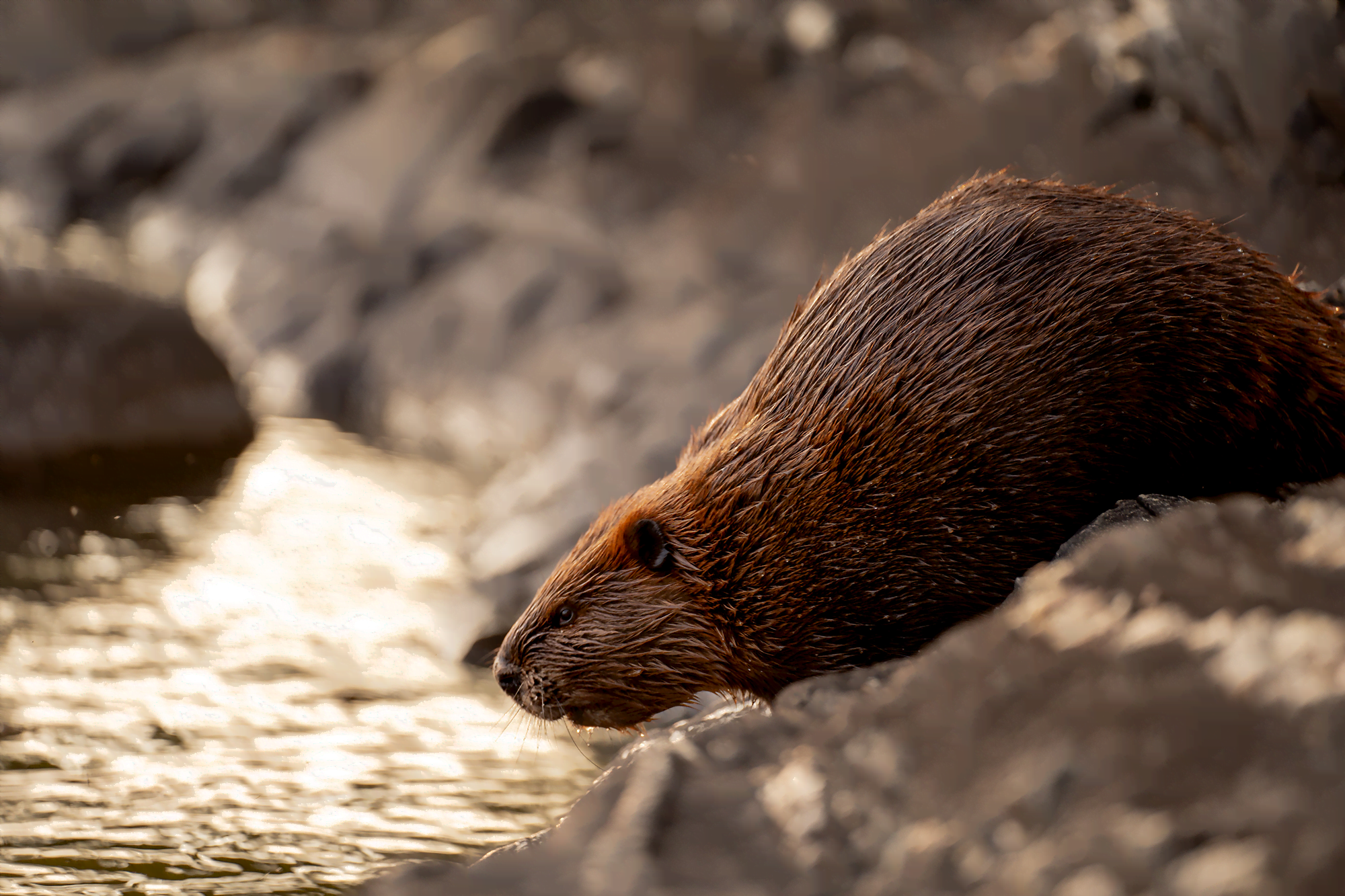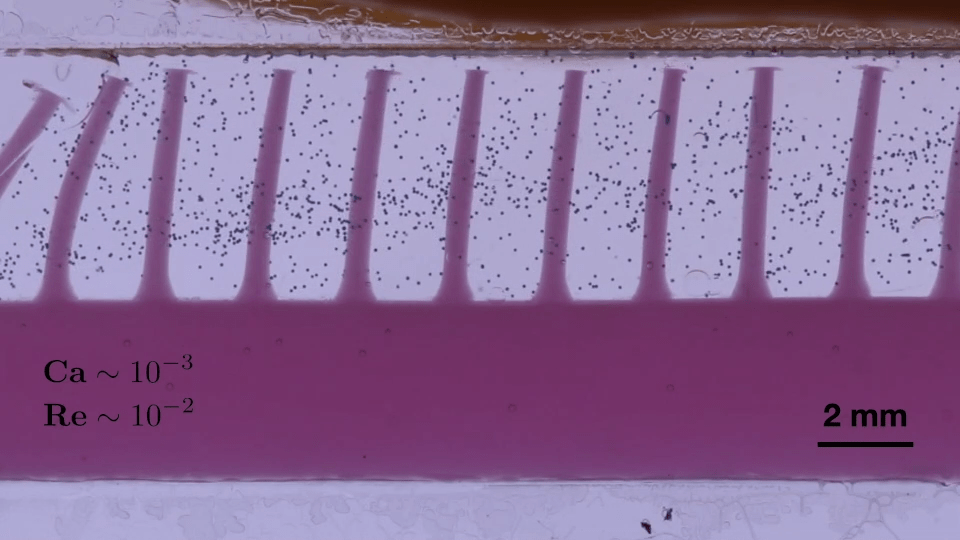Yellowstone National Park is always fascinating and surreal, but especially so in winter when volcanically-heated geysers and springs meet frigid, snowy weather. This short film from Drew Simms shows the park and its wildlife in the depths of winter. The bison rely on thick, shaggy fur coats to trap heat and keep dry. Steam and mist mingle around springs and giant plumes rise from geysers. What a strange and beautiful landscape! (Video and image credit: D. Simms)
Tag: hairy surfaces

Flexy Fur Foils Fouling
Inspired by a muddy hike with a dog, today’s study looks at how fur in a flow can shed dirt and debris. Researchers placed beaver, coyote, and synthetic hairs in a flow chamber with a slurry of titanium dioxide particles in water. After 24 hours, they counted the particles stuck on each hair. The more flexible a hair, the cleaner it stayed. Long hairs collected fewer particles per unit surface area than short ones, thanks to their larger deflection in the flow. The effect, they discovered, is a bit like when paint or glue dries on your hand. The more you move and flex your skin, the harder it is for crusty material to stick. This self-cleaning with flex and flow occurs in nature, too: the only furry mammal with consistently dirty fur is the notoriously inactive sloth. (Image credit: T. Umphreys; research credit: M. Krsmanovic et al.; via APS Physics)

Scuba-Diving Fly
Mono Lake, three times saltier than the ocean, is an extreme environment by any measure. But for the alkali fly, it’s home. This extremophile insect dives into the lake, protected by a bubble sheath, to eat and lay eggs. The fly’s wings and body are covered in tiny, waxed hairs that repel water. That traps a bubble of air around the insect, allowing it to breathe. Fresh oxygen can diffuse into the bubble from the water, replenishing the supply. (Image and video credit: Deep Look)

Bending in the Stream
Nature is full of cilia, hairs, and similar flexible structures. Unsurprisingly, flows interact with these structures very differently than with smooth surfaces. Here, researchers investigate flow in a channel lined with flexible, hair-like plates. Initially, the channel is filled with oil and dark particles that help visualize the flow. Then, they pump water into the setup.
As the water intrudes, it forms an interface with the oil. That interface is powerful enough to bend individual hairs in the system. When the hair bends far enough, it can touch its neighbor, sealing the oil inside the gap between them. Along the length of the channel, this behavior leads to trapped pockets of oil that never drain, no matter how much water flows by. (Image and research credit: C. Ushay et al.)

Honeybee Feeding
Busy bees feed on millions of flowers for each kilogram of honey they produce. To gather nectar, bees use their hairy tongues, which project out of a sheath-like cover. Protraction (i.e., sticking their tongue out) is relatively fast because all the hairs on the tongue initially lie flat. In the nectar, those hairs flare out, creating a miniature forest that traps viscous nectar and drags it back into the bee during retraction.

Bees feed by projecting their tongues into nectar. Tongue extension is faster because the tongue’s hairs lie flat. During the slower retraction phase, the hairs flare out, trapping nectar and pulling it back into the bee. Through modeling and experiments, researchers found that the time it takes a bee to retract its tongue depends on the bee’s overall mass. Smaller bees are slower to the retract their tongues, likely to allow enough time for their shorter tongues to capture enough nectar. With bee populations on the decline, the team’s predictions may help communities select flowers with nectar concentrations that best fit their local bees’ needs. (Image credits: top – J. Szabó, bee eating – B. Wang et al.; research credit: B. Wang et al.; via APS Physics)

Splashes on Hairy Surfaces
The question of whether a droplet will splash is a complicated one, even for smooth surfaces, but researchers are also interested in what happens to hairy surfaces when droplets strike. By varying the droplet viscosity and speed, along with the spacing of the hairs, researchers sketched out the variety of impacts one can get.
What happens during impact depends largely on how the kinetic energy of the droplet compares to the dissipation caused by interaction with the hairs. When the two balance, the droplet gets captured, like in the upper right image. If the hairy dissipation wins, you get a drop that stays mostly on the surface of the hairs. And if the kinetic energy outweighs the dissipation, you end up with a star-shaped splash that spreads between the hairs. (Image and research credit: A. Nasto et al.)

Hair in the Flow
Humans are hairy on the inside. Not in the way that we are on the outside, but in the sense that many interior surfaces of our bodies are covered in small, flexible, hair-like protrusions like the papillae on our tongues or the cilia in our intestines. Many of these fibers are immersed in fluids, raising the question of how the flow and the hairs interact. An elastic fiber immersed in a flow will bend in the direction of the flow (bottom); this helps reduce the drag and widens the channel flow goes through compared to a stiff, upright fiber.
But what happens when the fibers are all mounted at an angle? In this case, researchers found an asymmetric response. If flow moves in the direction of the fibers’ bend, the hairs don’t impend the flow at all. If flow moves against that direction, however, the hairs start to stand upright, blocking the flow channel and increasing the drag. The researchers suggest this sort of mechanism could be use in micro-hydraulic devices in the same way as a diode in a circuit – allowing flow in only one direction. For another biological example of flow control, check out how a shark’s denticles can prevent flow separation. (Image credits: hairy surface – J. Alvarado et al., flow around a hair – J. Wexler et al.; research credit: J. Alvarado et al.)

Hairy Surfaces Keep Skin Dry
Big animals like whales and sea lions stay warm in cold waters by having thick layers of insulating blubber. But smaller mammals, like beavers and sea otters, have a different mechanism for staying warm – their thick fur traps air near their skin, keeping the cold water at bay. Researchers used flexible, 3D-printed “hairy” surfaces to see how hair density, diving speed, and fluid viscosity affected the amount of air trapped between hairs. This enabled them to build a mathematical model describing the physics, which can now be used to predict, for example, the characteristics needed for a hairy wetsuit that could keep surfers warm in and out of the water. For more on this research check out MIT News’ video, and for a closer look at sea otter fur – not to mention a healthy overdose of pure adorable – check out the video below. (Photo credit: F. Frankel; video credit: Deep Look; research credit: A. Nasto et al.)






















